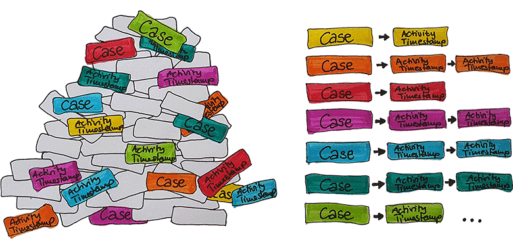What is the Kano model?

Kano series: Part 1 – the five categories, from attraction to rejection.
The Kano model describes the relationship between meeting customer expectations and customer satisfaction. It is therefore referred to as a model for customer satisfaction. Using the Kano model to analyse customer satisfaction is an efficient evaluation method when developing products to meet the desires and expectations of the target market. Using the Kano model, product managers can ensure that they develop their products in line with their customers’ wishes. Read on to find out more about the Kano model.
Characteristics of the Kano model
The model is named after a former professor at Tokyo University of Science, Noriaki Kano. He developed the model in the 1970s for the Konica Corporation (Now Konica Minolta).
The Kano model focuses on what your target market want and expect. Furthermore, the model distinguishes between two types of quality:
- Objective quality characteristics comprise physical characteristics and related functions meeting a certain level.
- Subjective quality characteristics are determined by individual preferences such as customer expectations.
By considering both types of quality, the Kano model enables you to not only focus on the functionality of the product or service in question, rather also how different perceptions of quality affect satisfaction.
A further categorisation looks at features and characteristics of an offering through the lens of customer expectations:
The Kano model’s quality categories
1) Threshold attributes
Originally known as must-be quality, the customers expect these as standard, indeed take these features for granted. They will not articulate a desire for these; they’re simply expected to be present. If these threshold attributes are missing, customers are dissatisfied. However, these features don’t evoke satisfaction in and of themselves, regardless of whether they are of particularly high objective quality.
These threshold features must, therefore be present and don’t cause any significant competitive advantage.
Examples of threshold attributes:
- Automatic channel scan (tuning) on a TV,
- Choosing from a selection of ringtones on a telephone,
- MP3 Player on your smartphone,
- Anti-rust coating on a car,
- Interior light in a fridge,
2) Performance attributes
Originally referred to as one-dimensional quality, these attributed are explicitly specified and requested by customers. They are decision-making criteria, or used to compare the performance of multiple offerings. They have a direct influence on customer satisfaction. Performance attributes are considered normal requirements which are known to the customer. They can evoke satisfaction but also dissatisfaction, depending on the extent to which they have been fulfilled.
Examples of performance attributes:
- Screen resolution for a PC monitor
- Battery time for a mobile phone
- How big the boot is in a car
- Acceleration speed for a motorbike
- How light a racing bike is
- Energy efficiency of a washing machine
- How much storage space there is in a fridge
3) Excitement attributes
Originally called attractive quality, these attributes excite your customers. They deliver a real – or at least, perceived – benefit. They are not a basic expectation so their absence doesn’t lead per se to dissatisfaction. If present, however, even a small increase in their performance is seen as a dispropotionately high benefit. Excitement attributes are also referred to as ʽdelightful requirementsʼ and raise the product above the competition by evoking a certain excitement in the customer. The product itself may not actually be that different to a competitor’s product, but the customer now perceives it as particularly useful or beneficial.
In today’s fiercely competitive markets, every manufacturer or service provider needs to be identifying these excitement attributes and working out how to integrate them into their offerings so that they can benefit from the disproportionately high increase in customer satisfaction. If a manufacturer doesn’t manage to add these, this doesn’t lead to dissatisfaction per se, as long as the performance attributes specified by the customer are present. However, if in a competitive, busy market, with many suppliers offering nearly identical products, identifying and adding excitement attributes can really raise your product above those of the competition.
Examples of excitement attributes:
- Special features
- Stylish design
- Guarantee or after-sales services
- Financing models
- Receiving a bottle of bubbly of a bunch of flowers when you buy a car
- Contactless payment by mobile phone
- Free parking with residents‘ permit
- A breakfast buffet consisting mainly of regional, organic products
4) Indifferent attributes
These don’t lead to either satisfaction or dissatisfaction, regardless of whether they are present or not. Essentially, their inclusion is only relevant for an extremely niche group. They are not expected by the customer, generally aren’t the deciding factor in whether a product is purchased, and are not worth including in marketing campaigns. Investing in these indifferent attributes is expensive and won’t help attract customers in decent numbers.
Examples of indifferent attributes:
- Being able to store more than 1,000 radio stations on a DAB radio
- Extending the range of emoticons stored on a smartphone
- Having a bible in your bedside cabinet in a hotel room
- Having a cigarette lighter in your car
- The hardware used by an IT provider to provide a service
5) Rejection attributes
lead to dissatisfaction if present, and don’t directly cause satisfaction if not. These attributes are critical to define as they are not always easily recognised as the reasons a potential customer does not buy your offering. This information is rarely articulated by a potential customer.
Examples of rejection attributes:
- Rust on the rims of your new car
- Damaged packaging
- Marks or stains on textiles
- A manual not being in the country language
- Food freshness
- A hotel next door to a shunting yard
- Impolite staff
Product managers can use the Kano model to ensure that the products they are developing are in line with what their customers want and expect. Conducting a Kano analysis shows tge direct relationship between the products characteristics and features and the resulting customer satisfaction. These results do not depend on what the product developers think or assume, neither are they based on theoretical models. They reflect real consumer opinion.
The Kano model can be used in several areas:
- Conducting a user-orientated analysis of expectations
- Analysing users‘ opinions of existing products
- Evaluating new product ideas
- Prioritising features and backlog for future development
- Differentiating between competitors
Kano Analysis
The following shows how the Kano model can be used for evaluation purposes.
Figure 1, below, makes clear the relationship between customers’ perceived satisfaction (the Y axis, vertical) and how their their expectations have been met regarding individual features and functions (The X axis, horizontal).
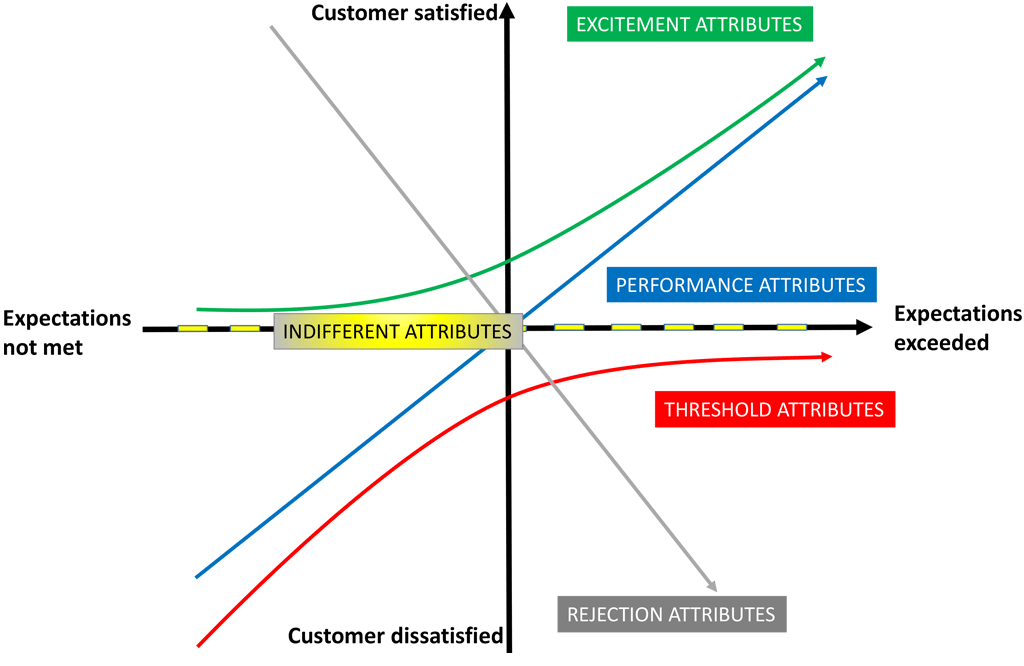
Regardless of the extent to which customer expectations are fulfilled for a threshhold attribute, you can see in the diagram above that the customer satisfaction it evokes never increases over a neutral level. For a performance attribute , however, the level to which expectations are met do affect satisfaction ratings. The better these expectations are fulfilled, the higher the customer satisfaction. If these expectations are exactly met, satisfaction is at a neutral level. For excitement attributes, it’s irrelevant to what extent expectations are fulfilled; just their inclusion leads to customer satisfaction, as long as the remaining expectations also meet expectations
- The Kano model is used to evaluate the features and charactertistics of your offering in regards to your target market’s expectations and satisfaction.
Examples of Kano diagrams
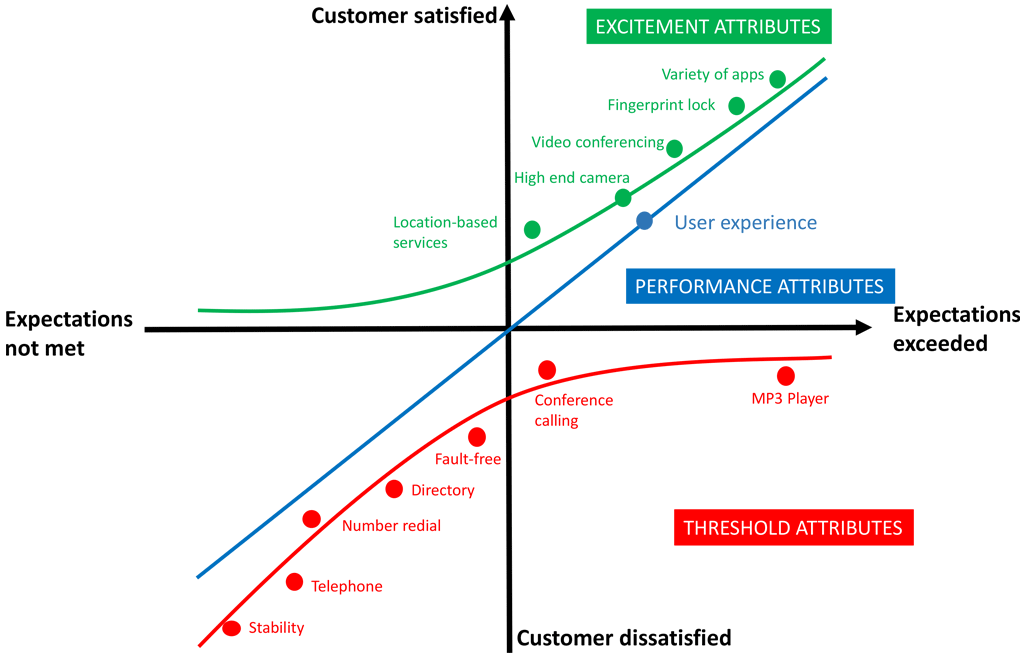

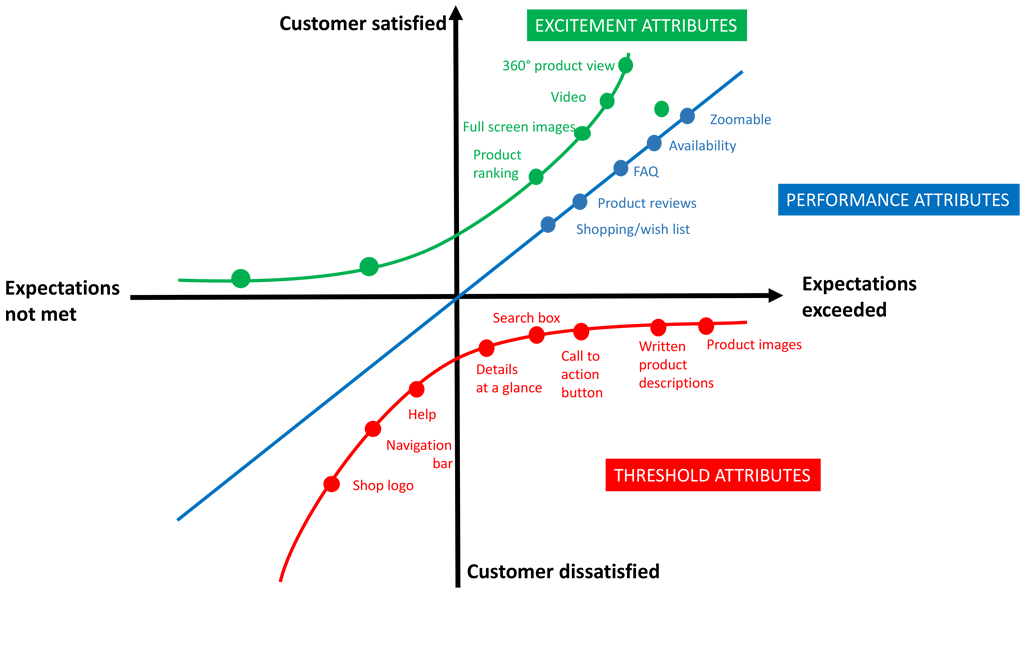
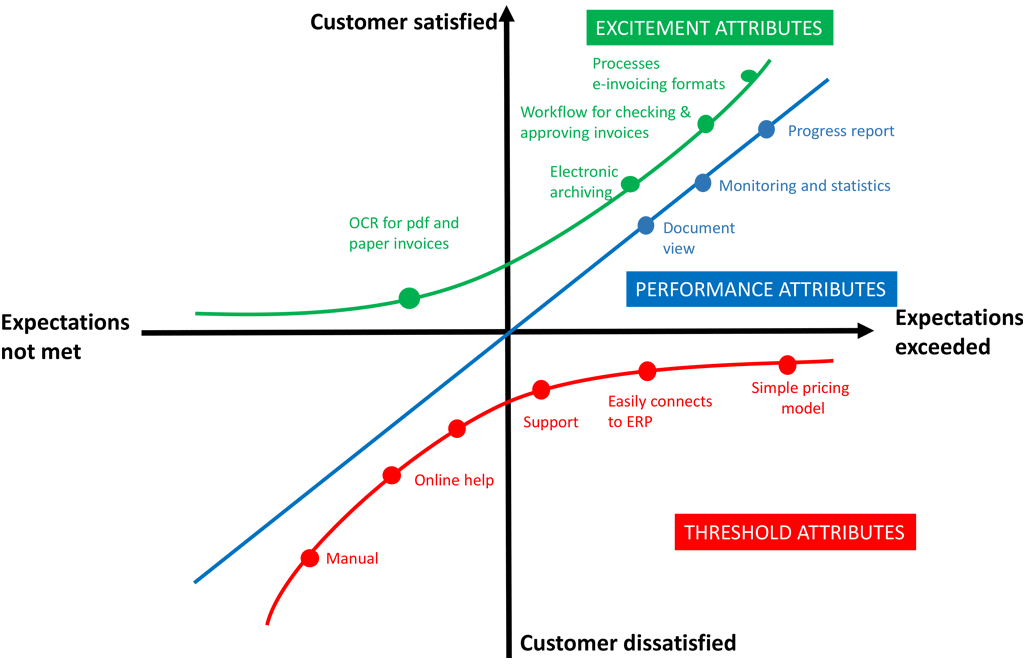
Kano Model – how a feature’s category changes over time
The classification of attributes in the Kano model changes over time. Something which excites customers today can already have become an explicit expectation tomorrow. Soon, it may well become something which i staken as given. This can be illustrated with a car’s airbag. When originally introduced by Mercedes Benz, it was an excitement attribute and showed that you had a higher range car. Soon, however, this feature was also present in cars by other manfacturers and had been downgraded to a performance attribute. Nowadays, airbags are a threshhold attribute, included as standard in even cars in the lowest price class.

This downgrading over time is due to the fact that customers get used to new features quickly. Exactly when these start to be taken from granted depends on the type of feature, competitors‘ designs, and the customers themselves. In order to keep abreast of this eventual downgrading and react appropriately, a Kano analysis needs to be carried out at regular intervals.
Conclusion: The Kano model helps improve customer-orientation
In order to gain – and maintain – a competitive edge, a company really needs to be aware of their target customers‘ changing and increasing expectations. The Kano model helps to understand the different perspectives in the target market and thus makes a significant contribution to developing customer-orientated products and services.
Thank you for your message
We appreciate your interest in SEEBURGER
Get in contact with us:
Please enter details about your project in the message section so we can direct your inquiry to the right consultant.
Written by: Rolf Holicki
Rolf Holicki, Director BU E-Invoicing, SAP&Web Process, is responsible for the SAP/WEB applications and digitization expert. He has more than 25 years of experience in e-invoicing, SAP, Workflow and business process automation. Rolf Holicki has been with SEEBURGER since 2005.



